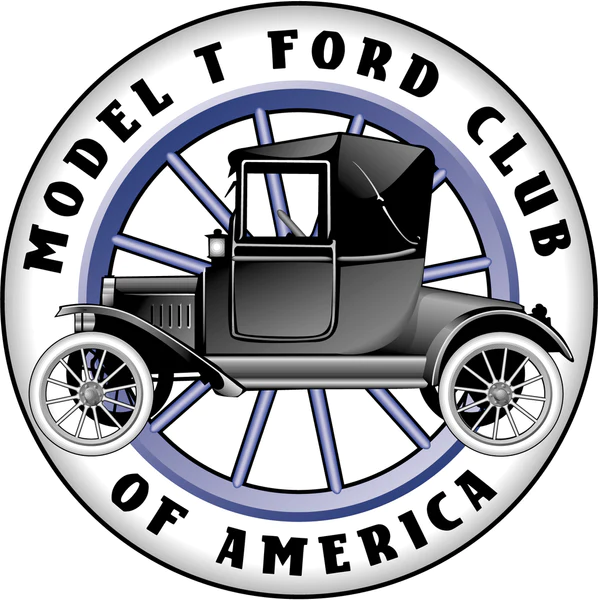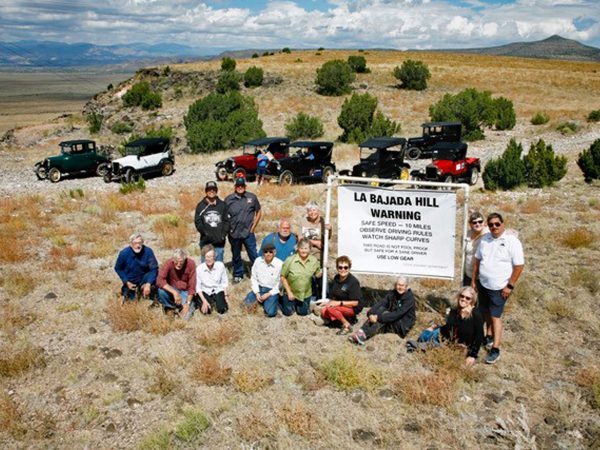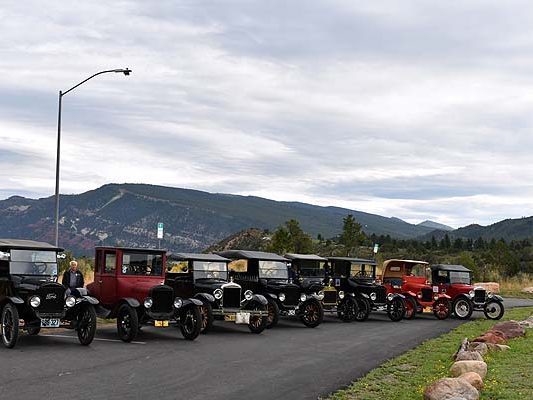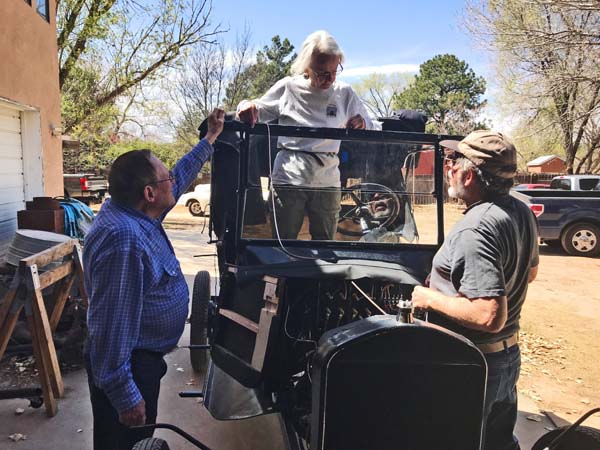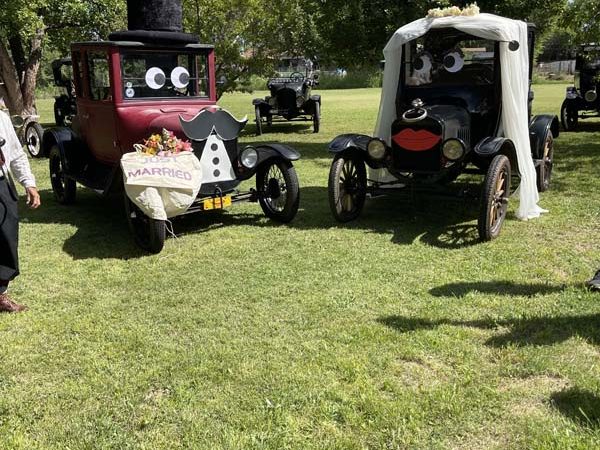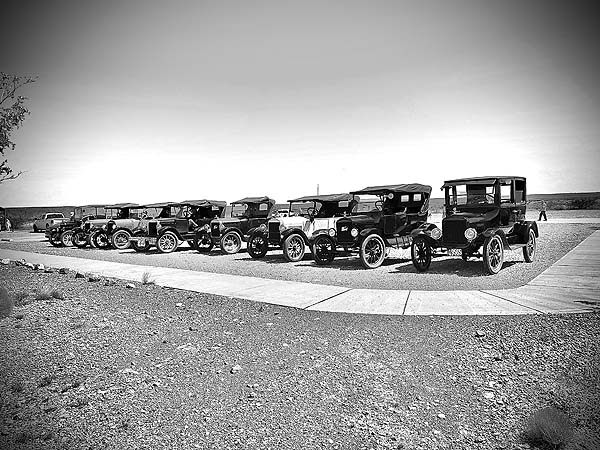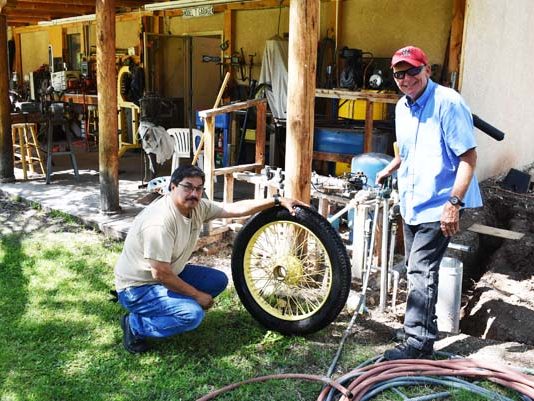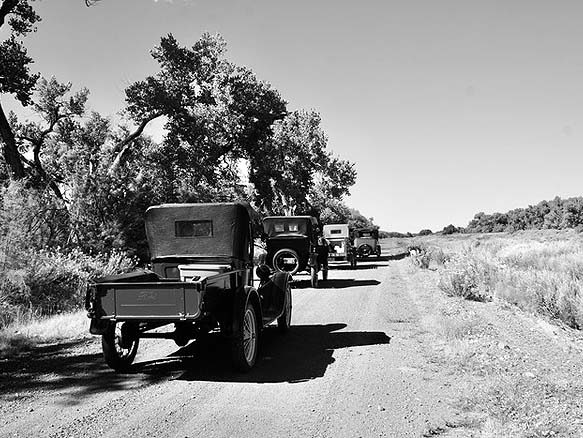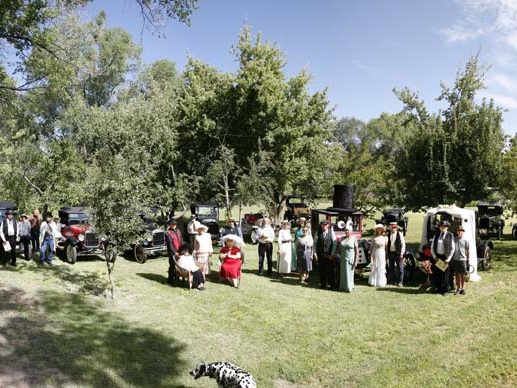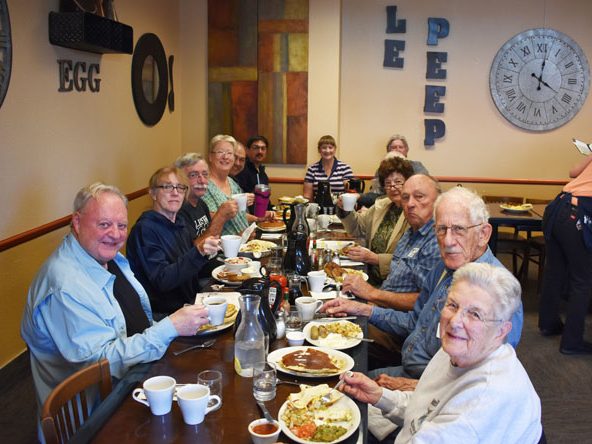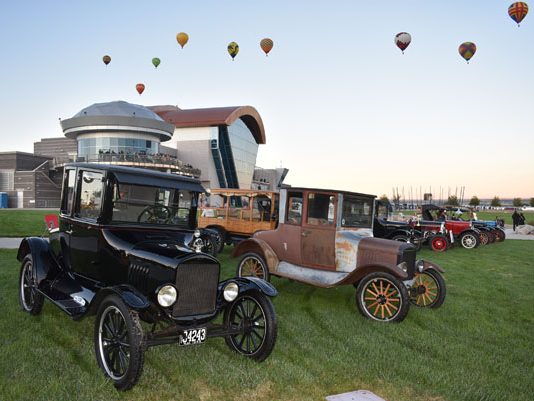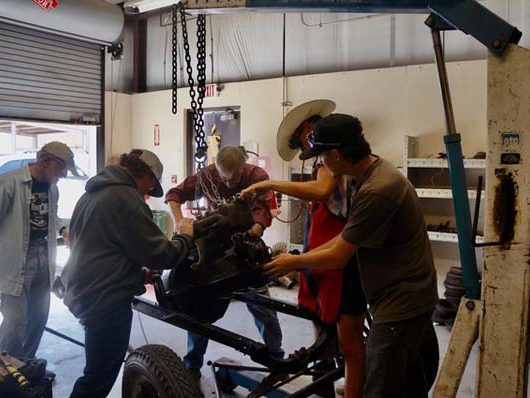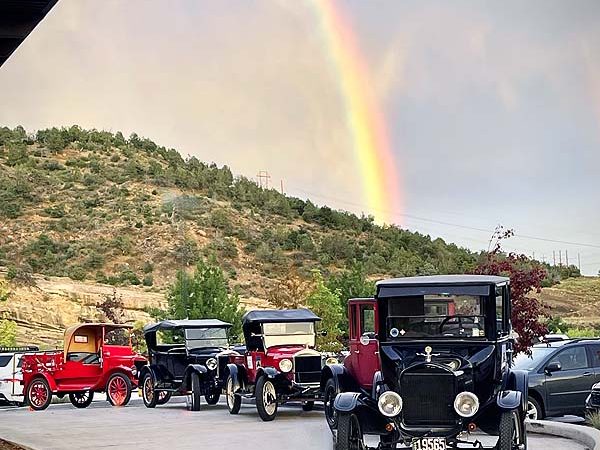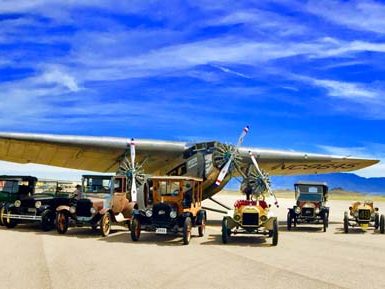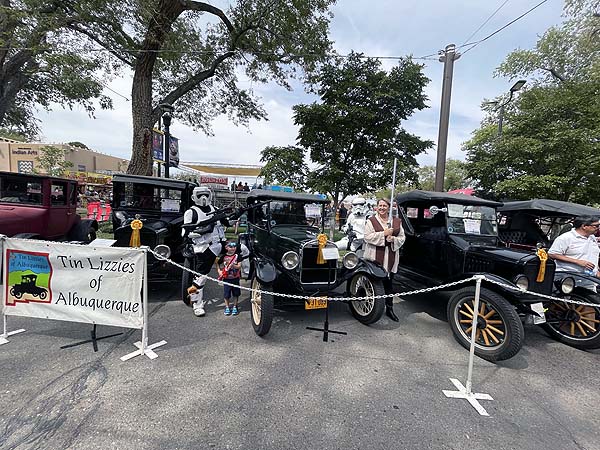By Jahn Wright (Cover story from the Nov. – Dec. 2020 Enchantment Flyer)
Way back in the fall of 1924, a Ford Model T coupe was born. The engine was born in May 1924, but it wasn’t until late in the year that the car was assembled. A few features mark it as a 1925; the doors are all steel and the carburetor choke/mixture control terminates in a U-joint at the carburetor the same as the 1926-1927 models. Would I attempt a complete restoration like this again? — in a word “NO”, but history weighed heavily in this situation. History also outweighed finances; the cost of the restoration is undoubtedly well above the value of the vehicle now. No, I don’t have a good accounting of what was spent over the last 20+ years nor do I have an expert appraisal of the current value.
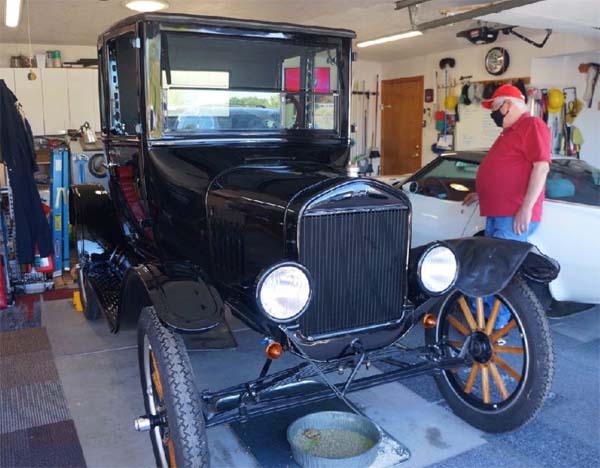
Jahn Wright with his grandfather’s 1925 Model T coupe pictured in
his home garage shop. (Photo by Paul Duncan)
With that background, the history which influenced me to take on the project was, in fact, family history. This vehicle was originally owned by my maternal grandfather, at least as far back as 1935 and I have a registration slip with his signature that verifies this. During this time of his ownership, he was a farmer and a rural mail carrier in Iowa with three daughters in college during the Depression. As you may know, in the 1930s through 1950s, the roads in the rural Midwest were mostly dirt surfaces with some main routes receiving gravel. A few were even paved, but not in the town or surrounding areas where my family lived.
In those days, a rural mail carrier abided by the famous mottos “the mail must go through” or “neither snow nor rain nor heat nor gloom of night stays these couriers from the swift completion of their appointed rounds”. Well, the climate in Iowa included frequent rain, snow, heat, cold, humidity, mud, thawing mud, and other fun aspects that served to stir up road surfaces. During restoration, I found that the trunk area of the car had been the recipient of muddy tire chains on numerous occasions. The tire chains weren’t included but some of the dried mud was still in the car when I acquired it in 1996. Needless to say, the Iowa humidity facilitated the formation of rust in these areas! Fortunately, the rust was mostly restricted to the fenders and trunk. I was also able to secure a new trunk floor and replace the fenders with newly manufactured ones much cheaper than the cost of body work to straighten and refurbish the originals. The gentleman who painted the car also patched up the few small rust holes in the body.
During my youth (yes long, long ago— in the 1950’s), I remember playing in this car which was housed in the barn on our property in Iowa. My parents inherited it when my grandfather died in the late 1940’s. I vaguely remember riding with my father when he used it to travel to our nearby property to tend the livestock. For several years, he used it on the same rural mail route as my grandfather had served. Dad also used it for farm chores when the weather was bad as he only had this vehicle, a family car, and a tractor—until several years later when he acquired a pickup and the Model T was relegated to static display in the barn.
When our family moved from Iowa to Arizona in 1961, we stored the Model T in Iowa for a year or so until Dad could get it moved to Arizona. It lived in our Arizona carport for a few years and I actually drove it around the block once or twice while in college in 1962 or 1963. I used paint remover to start the restoration process. This was well prior to the era of easy replacement parts availability that we have now. And some of the primer I applied in the mid-1960’s (probably no longer available thanks to EPA regulations) stayed firmly attached until I removed it in 2005-2006.
When my Dad passed away in 1995, I inherited the Model T. After several years in my garage in Albuquerque with little real progress, in 2003 several members of the Club (3 of them no longer with us) helped with the disassembly. We transported the body to a storage facility and I arranged with Clarence Schritter to rebuild the engine and transmission. George Azevedo (Larry’s father) rebuilt the rear axle during one of his visits to Corrales. Meanwhile, I worked on getting some parts cleaned, sandblasted, and painted.
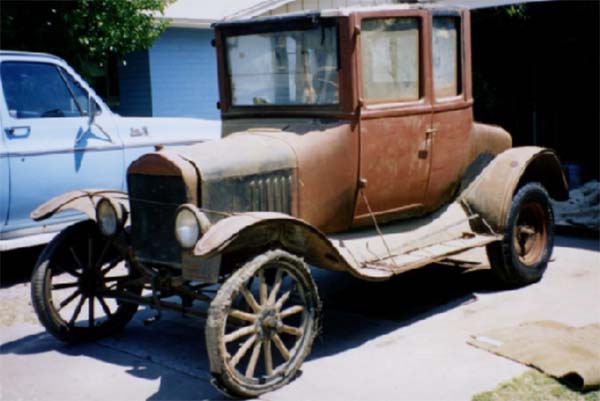
In 2004, we decided to move to a newer home so I was forced to move many parts to the new home and some to a storage facility on the West side. Moving this car around, either whole or in pieces, seems to be a pattern—Iowa to Mesa, Arizona to Albuquerque to Rio Rancho. Anyway, our new house in Rio Rancho had a 3-car garage with enough space to work on the vehicle so I finally got started on the restoration in earnest—about nine years after transporting the vehicle from Arizona to Albuquerque. One of the first tasks was to replace the wood surrounding the roof—it was damaged by being parked for a time in a shed with a leaky roof (yes, rain in Arizona!) and my Dad had attempted to repair it, but I was able to purchase a complete wood kit to fix it correctly. I also spent a lot of time fitting new front door pillars since they were also damaged. I definitely don’t recommend that exercise as a fun way to spend garage time.
Eventually, my son and I managed to get the wood fitted and installed to our satisfaction. I also replaced some wood pieces under the floor and perhaps should have done a complete re-wood, but I decided that was too extensive and expensive a project for me to undertake. Advice to would-be restorers: choose a year and body style with not too much wood unless you already have skills as a cabinet maker.
I elected not to have the body sand or media- blasted for rust and paint removal because of the danger of warping the sheet metal. Anyway, I used various abrasive means to remove from the body Henry Ford’s rather stubborn paint as well as the primer I had added during my college years. It was a slow process aided by my bead blasting cabinet for small parts but eventually I deemed everything ready to be painted.
After investigating various painters, most of whom wanted to do it “their way or else” at a high price, I settled upon a painter in Los Lunas recommended by a fellow Corvette owner. He was happy to take it, we agreed on a price (still pretty high), and I transported the body to him in late 2013. About two months later, he called for me to pick it up. He did a great job although I’ve managed to add a couple of scratches here and there during assembly. Recently I installed the upholstery—aided by a video produced by the gentlemen who sewed up the various pieces of the puzzle.
Our club members, the MTFCA videos, Google, the various vendors, and the MTFCA Forum are great restoration resources—just try to filter the facts vs. opinions on the Forum. I used up one air compressor. I’ve added a drill press, die grinders, electric grinders, a bead blasting cabinet, a rivet gun, bucking bars and other rivet tools, sheet metal dollies, air stapler, tack hammer, staple remover, lots of various chemicals, and parts. I’ve found one tool to cure almost everything—credit cards. Although still not quite complete, I’ll pass the car on to my son and am sure this Model T will continue its history in our family.
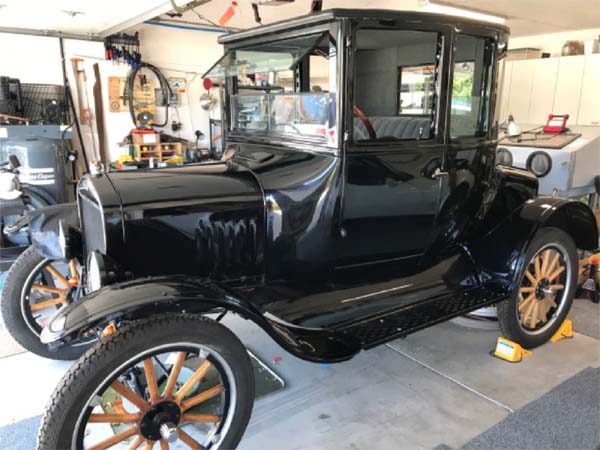
(Photo by Jahn Wright)
